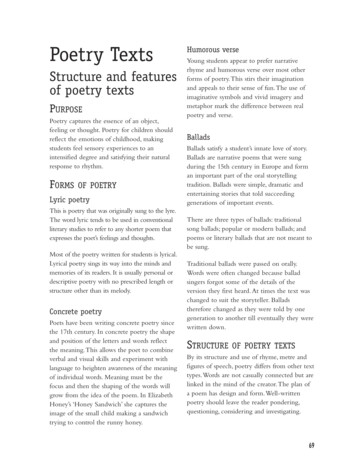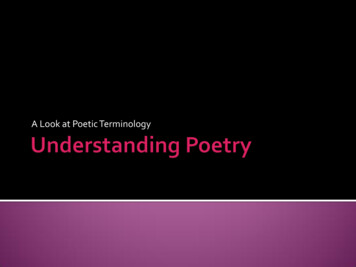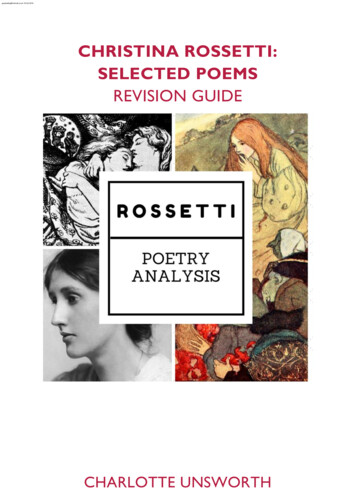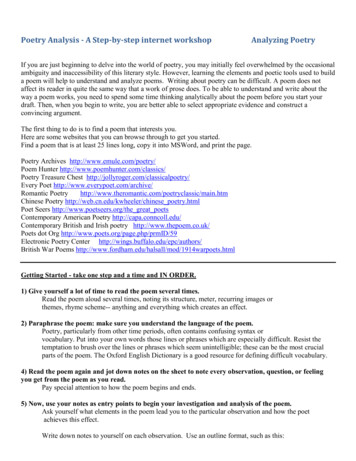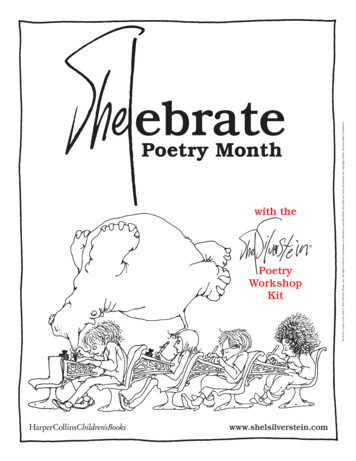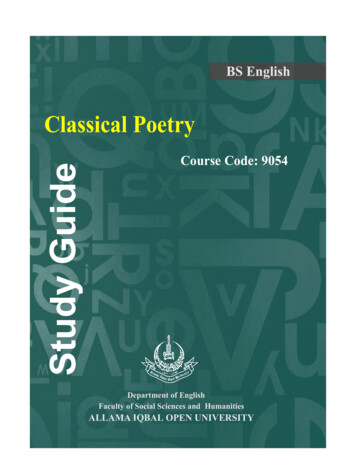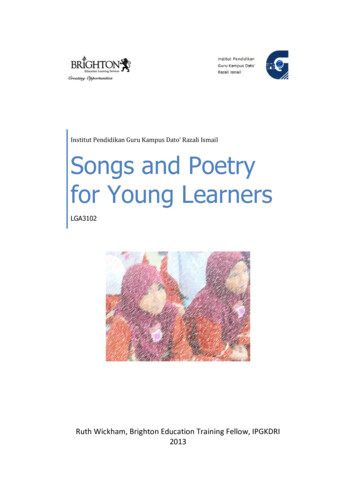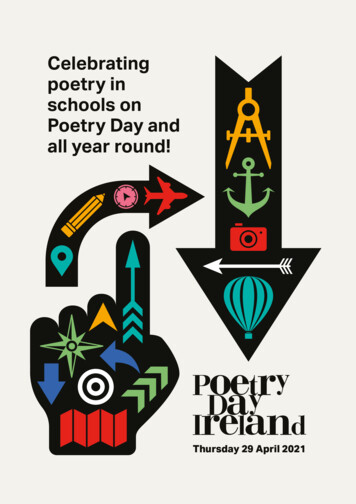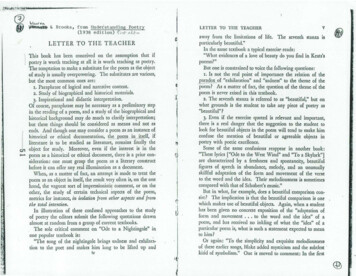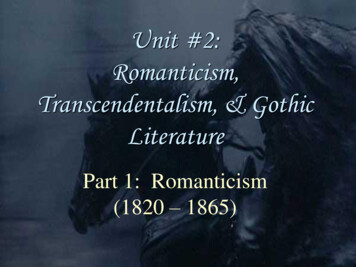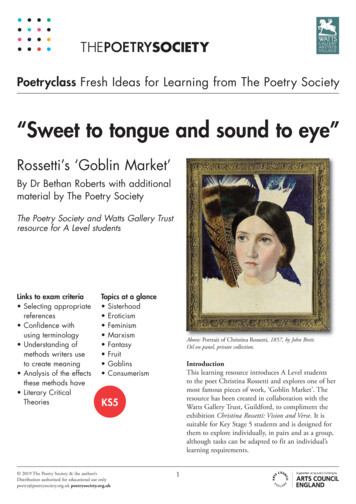
Transcription
Poetryclass Fresh Ideas for Learning from The Poetry Society“Sweet to tongue and sound to eye”Rossetti’s ‘Goblin Market’By Dr Bethan Roberts with additionalmaterial by The Poetry SocietyThe Poetry Society and Watts Gallery Trustresource for A Level studentsLinks to exam criteria Selecting appropriatereferences Confidence withusing terminology Understanding ofmethods writers useto create meaning Analysis of the effectsthese methods have Literary CriticalTheoriesTopics at a glance Sisterhood Eroticism Feminism Marxism Fantasy Fruit Goblins ConsumerismAbove: Portrait of Christina Rossetti, 1857, by John Brett.Oil on panel, private collection.IntroductionThis learning resource introduces A Level studentsto the poet Christina Rossetti and explores one of hermost famous pieces of work, ‘Goblin Market’. Theresource has been created in collaboration with theWatts Gallery Trust, Guildford, to compliment theexhibition Christina Rossetti: Vision and Verse. It issuitable for Key Stage 5 students and is designed forthem to explore individually, in pairs and as a group,although tasks can be adapted to fit an individual’slearning requirements.KS5 2019 The Poetry Society & the author/sDistribution authorised for educational use onlypoetry@poetrysociety.org.uk poetrysociety.org.uk1
Christina Rossetti, her family and circleChristina Georgina Rossetti (1830–94) was born on5 December 1830 to Italian parents, the youngest offour children. Her siblings included poet and artistDante Gabriel and critic and editor William MichaelRossetti, founders and members of the literary andartistic movement the Pre-Raphaelite Brotherhood.The Brotherhood were a group of exclusively maleartists, poets, and critics – formed in part in a revoltagainst the ugliness of modern life and dress – whosework shared an emphasis on fidelity to nature, moralseriousness and religious themes, with a strongmedieval influence.Rossetti was educated at home, and, after ill health cutshort her work as a governess, she led a quiet, solitarylife of writing, religion and volunteer work. Rossettireportedly gave up playing chess and going to thetheatre as secular pleasures that might interfere withher deep religious devotion. She was briefly engagedto the painter James Collinson – also a member of thePre-Raphaelite Brotherhood – yet the engagement brokeoff due to religious reasons and Rossetti never married.Image, top right: Gabriel and Christina, 1922, by Max Beerbohm.From Rossetti and his Circle (London: William Heinemann).Collection of Stephen Calloway.Literary careerRossetti is said to have started composing poems atthe age of eleven, and began to be published inperiodicals when she was eighteen. Goblin Market andOther Poems appeared in 1862 when she was thirtytwo. On reading ‘Goblin Market’, the Victorian criticJohn Ruskin declared that Rossetti’s “irregularmeasures” were the “calamity of modern poetry” andthat she “should exercise herself in the severestcommonplace of metre until she can write as thepublic like”. However, it was received by most criticsand readers with great enthusiasm. Goblin Market andOther Poems was followed by The Prince’s Progress andOther Poems in 1866, Sing-Song, a Nursery Rhyme Bookin 1872, and A Pageant and Other Poems in 1881.Rossetti also published poems elsewhere and wrotenumerous prose works, including Speaking Likenesses(1874), a collection of fairy-tales, andTime Flies: A Reading Diary (1885). 2019 The Poetry Society & the author/sDistribution authorised for educational use onlypoetry@poetrysociety.org.uk poetrysociety.org.ukPoetic styleRossetti’s verse spans fantasy and children’s verse,ballads, love lyrics, sonnets, and religious poetry. Herpoems are celebrated for their technical virtuosity andexperimental forms, their simple diction andbeautiful, languid imagery. Much of her poetry reflectsher strong religious beliefs and explores themes of loss,melancholy, death, secrets, veiled eroticism andunhappy or frustrated love. Although she wascelebrated during her lifetime, Rossetti received littleattention in the first half of the twentieth century. Itwas only with the influence of feminist literarycriticism in the 1970s that Rossetti was rediscoveredand re-established as a central Victorian poet, and herpoems, especially ‘Goblin Market’, now have a firmplace in the literary canon.2
‘Goblin Market’ and its context‘Goblin Market’ tells the story of two sisters, Lauraand Lizzie, and their twilight encounter with goblinmerchants, who tempt them with their criesadvertising luscious “orchard fruits”. While Lizzieresists, Laura succumbs to temptation, exchanging alock of her golden hair for the “fruit forbidden”. Atfirst, both sisters appear unchanged yet differencessoon become apparent. Laura realises she can nolonger hear the goblins’ cries – and thus buy and tastethe fruit – and “her tree of life drooped from theroot”. Her hair greys, and she deteriorates until she is“knocking at Death’s door”. Her sister returns to thegoblins and offers to pay the goblins for more fruit,which she hopes will act as an antidote to Laura’smalady. The goblins attack Lizzie violently, smearingtheir fruits against her mouth in a vain attempt tomake her eat (sometimes read as a rape scene). Afterthe goblins are “worn out by her resistance”, Lizziereturns home, and Laura kisses the juices– which arenow loathsome to her – from her sister’s face and all isrestored. This “fiery antidote” has worked. The poemends by looking forward to when Lizzie and Laura arewives with children. We see them all join hands andutter the poem’s supposed moral altogether.‘Goblin Market’ has been aligned with a number ofliterary genres including the fairy tale, fable, gothic,fantasy and biblical. On its publication, the Spectatordescribed the poem as “a true children’s poem”, yetRossetti was not writing for children during thisperiod and in 1862 wrote a letter (7 March) decliningto contribute to a children’s book, commenting that“children are not among my suggestive subjects”.Rossetti herself claimed that she “did not meananything profound” by the poem, yet it has sparkednumerous interpretations – as a rewriting of thecreation myth from the book of Genesis, acommentary on consumerism, a tale about eatingdisorders, a feminist manifesto, and an explorationof lesbian love (to name but a few). It has influenced anumber of successors including Lewis Carroll’s Alice’sAdventures in Wonderland (1865).Rossetti wrote ‘Goblin Market’ in 1859 while she wasvolunteering at the St Mary Magdalene Penitentiary inHighgate, which was dedicated to the reform andrehabilitation of prostitutes. Some critics haveidentified themes in the poem – temptation, sexualexchange and sisterly redemption – that reflect this,suggesting that Rossetti might have composed thepoem with the intention of reading it aloud at thePenitentiary as a moral lesson or sympatheticnarrative. Rossetti demonstrated an interest in ‘fallenwomen’ in her other writings, such as the poems‘Cousin Kate’ (1862) and ‘The Iniquity of the Fathersupon the Children’ (1866), both of which centre onfemale characters who bear illegitimate offspring.Perhaps the best known of Rossetti’s poems, ‘GoblinMarket’ is also considered one of her mostcharacteristically ‘Pre-Raphaelite’ works because of itspainterly richness and pictorial details (reflected in thenumber of illustrations the work has prompted). Italso appeals to the senses in other ways: particularlytaste, in the (initially) enticing richness of the fruit,but also through sound, the exotic and intoxicatingsound and rhythms of the poem itself.Christina Rossetti’sGoblin Market andOther Poems with acover illustration byher brother DanteGabriel Rossetti. 2019 The Poetry Society & the author/sDistribution authorised for educational use onlypoetry@poetrysociety.org.uk poetrysociety.org.uk3
Reading ‘Goblin Market’Consider these lines from the start of the poem, whichpresent the direct, reported speech of the goblins whospeak in the strange language of Rossetti’s poetry:Come buy our orchard fruits,Come buy, come buy:Apples and quinces,Lemons and oranges,Plump unpeck’d cherries,Melons and raspberries,Bloom-down-cheek’d peaches,Swart-headed mulberries,Wild free-born cranberries,Crab-apples, dewberries,Pine-apples, blackberries,Apricots, strawberries;—All ripe togetherIn summer weather,—Morns that pass by,Fair eves that fly;Come buy, come buy:Our grapes fresh from the vine,Pomegranates full and fine,Dates and sharp bullaces,Rare pears and greengages,Damsons and bilberries,Taste them and try:Currants and gooseberries,Bright-fire-like barberries,Figs to fill your mouth,Citrons from the South,Sweet to tongue and sound to eye;Come buy, come buy. (3-31) 2019 The Poetry Society & the author/sDistribution authorised for educational use onlypoetry@poetrysociety.org.uk poetrysociety.org.ukGather Ye Rosebuds While Ye May, 1908, by John WilliamWaterhouse – an example of a late Pre-Raphaelite painting.4
Task 1Individual or group workAs we can see from this passage, essentially a list,‘Goblin Market’ is brimming with poetic devices andis notably experimental and unusual. Read this passagealoud a few times (which will help your understandingof the poem) and mark up your copy with thefollowing devices:Task 2 rhyme scheme (look out for rhymes which mayoccur quite far apart) different line lengths different rhythms stressed / unstressed syllables assonance alliteration repetition patterning internal rhyme enjambment mark the pauses and any other surprising effectsthat you noticeDiscuss with a partner why you think Rossetti chosethe devices identified in the passage on page 4. Whatwords or phrases are accentuated, changed, or drawntogether through sound and their placement in thepoem? What effect did they have on the way you readit aloud? (Rhyme and aspects of form can createsurprising effects and relationships between words andimages, which prose is sometimes unable to do.) Howdo form and content work together? What is beingdescribed with how it is being described?One interesting way in which to read this passage isthat the strangeness and richness of the form andlanguage mimic that of the fruit, luscious andintoxicating; form and content are working together.Discussion pointWhat is the effect of the abundance of poetic devicesand irregular form?Questions to consider What commands add to the urgency? Is it thecommands that add to the urgency? Why is it such a long list? Do persuasive features create a sensual feel? 2019 The Poetry Society & the author/sDistribution authorised for educational use onlypoetry@poetrysociety.org.uk poetrysociety.org.ukPartner5
Task 3PartnerRead aloud and look at the excerpt from ‘GoblinMarket’, below right. This is the part of the poemwhere Laura has eaten the fruit, but the effects are notyet evident. In this way, the fruit suggests thetemptations of poetry, we almost ‘taste’ the language.This reading is perhaps supported by the amount ofreferences to hearing and speaking, mouths and lips inthe poem, all of which are crucial to poetry of course.Some critics have read the poem as Rossetti’s own‘transgression’ as a woman writer in the maledominated Victorian artistic world, whereby writingthe poem is akin to eating the forbidden fruit (seeSandra Gilbert and Susan Gubar, The Madwoman inthe Attic). To critic Lorraine Kooistra, the poem isabout interpretation itself. Referring to the passageabove she writes that: “one sister interprets thesematerial signs correctly; one does not.”‘Golden Head by Golden Head’. Wood engraving by W.J. Lintonafter Dante Gabriel Rossetti, with corrections by Kate Faulkner.Collection of Stephen Calloway.from ‘Goblin Market’Golden head by golden head,Like two pigeons in one nestFolded in each other’s wings,They lay down in their curtained bed:Like two blossoms on one stem,Like two flakes of new-fall’n snow,Like two wands of ivoryTipped with gold for awful kings.Moon and stars gazed in at them,Wind sang to them lullaby,Lumbering owls forbore to fly,Not a bat flapped to and froRound their rest:Cheek to cheek and breast to breastLocked together in one nest.Discuss with your partner what Rossetti is trying tosay about the sisters in the section of the poem below.Then look out for how the form (e.g. repetition, wordorder, line breaks, lists, line length, rhythm) supportsand enhances this. 2019 The Poetry Society & the author/sDistribution authorised for educational use onlypoetry@poetrysociety.org.uk poetrysociety.org.uk6
Task 4Before you start, think about What style will you choose? Fairy tale, folktale,morality tale, horror story.? What will you elaborate on or leave out? Will you set the poem in the Victorian era or today? What audience will you aim for? Children,teenagers, adults? Do you think Rossetti’s poem has a moral? Willyou accentuate this or change it?IndividualRossetti chose to write ‘Goblin Market’ as a narrativepoem. To understand the particular opportunitiesoffered by this poetic form, try changing it to anotherform entirely: Rewrite the poem in prose as a short story, or Tell it as a story, out loud, or Choose key scenes and create a (quick) cartoonShare your new creative work with a partner anddiscuss the following:What are the key differences when you tell the poem in another form?What techniques could you not use, or felt you used to less effect?Do you feel like anything was lost? Or gained?Are there any similarities in techniques between your story and Rossetti’s poem?Do you think your story has a moral? How would you summarise it? Do you think it is different toRossetti’s? Is it more or less obvious? 2019 The Poetry Society & the author/sDistribution authorised for educational use onlypoetry@poetrysociety.org.uk poetrysociety.org.uk7
Literary critical theoryAs A Level students, you need to consider a varietyof critical thinking in relation to literary works.What are the different interpretations of Rossetti’spoem? Would a feminist interpretation see this asa celebration of sisterhood or a presentation of thedifficulties women faced at this time? Would apsychoanalytical interpretation see this as two aspectsof one psyche or would it simply discuss the sexualityexplored in the poem? Would a Marxistinterpretation discuss how this presents the differentdomestic and commercial spheres of life? Below is alist of suggested further reading to help you exploreliterary critical theory in relation to Rossetti’s work.About the authorDr Bethan Roberts is the William Noble researchfellow at University of Liverpool. Her researchinterests include: women’s writing; form and literaryhistory; Romanticism, nature writing and birds inliterature and science. Her book Charlotte Smith:Place, Tradition and Form in the Late EighteenthCentury is forthcoming (Liverpool University Press)and she is current researching nightingales in literaryhistory and writing Nightingale for the ‘animal’series from Reaktion Press.The Poetry SocietyThe Poetry Society is the leading poetry organisationin the UK. For over 100 years we’ve been a lively andpassionate source of energy and ideas, opening up andpromoting poetry to an ever-growing community ofpeople. We run acclaimed international poetrycompetitions for adults and young people, andpublish The Poetry Society, one of the most influentialpoetry magazines in the English-speaking world. Withinnovative education and commissioning programmes,and a packed calendar of performances asnd readings.The Poetry Society champions poetry for all ages.BibliographyIan Buchanan, Oxford Dictionary of Critical Theory(Oxford University Press, 2010)Andrew Bennett and Nicholas Royle, An Introductionto Literature, Criticism and Theory (Routledge, 2016) –chapters on Ideology, Gender Difference, Queer.Sandra M. Gilbert and Susan Gubar, The Madwomanin the Attic: The Woman Writer and the NineteenthCentury Literary Imagination (New Haven, 1979),pp. 564-75Terrence Holt, ‘“Men Sell Not Such in Any Town”:Exchange in Goblin Market’, Victorian Poetry, 28.1(1990), 51-67Kristal Lysack, ‘Goblin Markets: Victorian WomenShoppers at Liberty’s Oriental Bazaar’, NineteenthCentury Contexts, 27.2 (2005), 139-65Victor Roman Mendoza, ‘“Come Buy”: The Crossingof Sexual and Consumer Desire in Christina Rossetti’s‘Goblin Market’’, ELH, 73.4 (2006), 913-47Lorraine Kooistra, ‘Christina Rossetti’ in TheCambridge Companion to the Pre-Raphaelites, ed.Elizabeth Prettejohn, Cambridge, 2012), pp. 164-82The Foyle Young Poets of the Year Award is at thecore of The Poetry Society’s extensive educationprogramme. It sits alongside SLAMbassadors UK,which champions young spoken word talent, andYoung Poets Network, our online hub for youngwriters where we post challenges, competitions andfeatures throughout the year. We also run specialprojects, including the recent collaborations with theNational Maritime Museum, the Royal NorwegianEmbassy, Bletchley Park and Oxfam. As well as theseprojects, we offer a variety of resources includingschools membership and packages, Poetryclass INSETtraining and lesson plans, youth membership and aPoets in Schools consultancy service.This resource was commissioned by Watts GalleryTrust and The Poetry Society and written by DrBethan Roberts with additional material fromThe Poetry Society. 2019 The Poetry Society & the author/sDistribution authorised for educational use onlypoetry@poetrysociety.org.uk poetrysociety.org.ukwww.poetrysociety.org.uk8
ballads, love lyrics, sonnets, and religious poetry. Her poems are celebrated for their technical virtuosity and experimental forms, their simple diction and beautiful, languid imagery. Much of her poetry reflects her strong religious beliefs and explores themes of loss, melancholy, death, secrets, veiled eroticism and unhappy or frustrated love.
